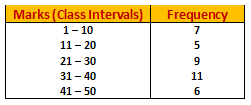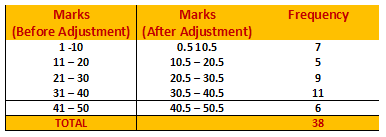CLASS-9
RULES TO CONVERT FROM DISCONTINUE FORM TO CONTINUE FORM
Rule to Convert Discontinuous (or Inclusive) Form to Continuous (or Exclusive) Form –
In a Discontinuous interval or inclusive form, we have :-
Adjustment Factor =
1
------ [(Lower Limit Of One Class – Upper Limit Of Previous Class)]
2
Thus, if the classes are 1 – 10, 11 – 20, etc., then
1
Adjustment factor = ------ (11 – 10) = 0.5
2
To convert data given in discontinuous form to the continuous form, we subtract the adjustment factor from each lower limit and add the adjustment factor to each upper limit to get the true limits.
Example) Convert the following frequency distribution from discontinuous to continuous form :

1
Ans.) Adjustment Factor = ------- (11 – 10) = 0.5
2
Subtract 0.5 from each lower limit and add 0.5 to each upper limit. Then, the required table in continuous form may be prepared as under –
